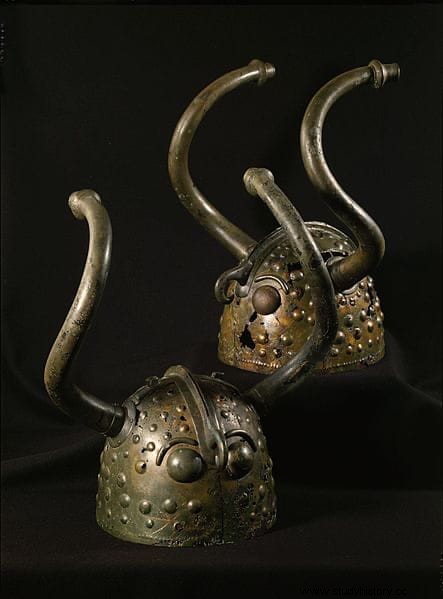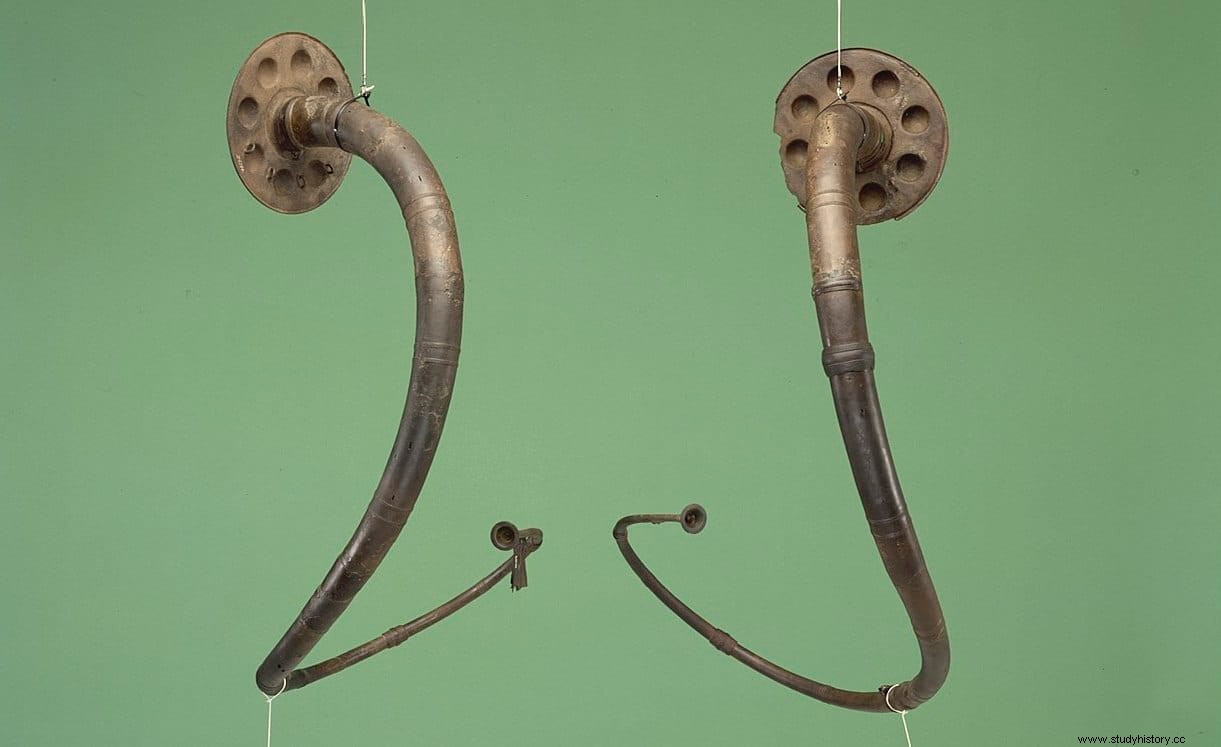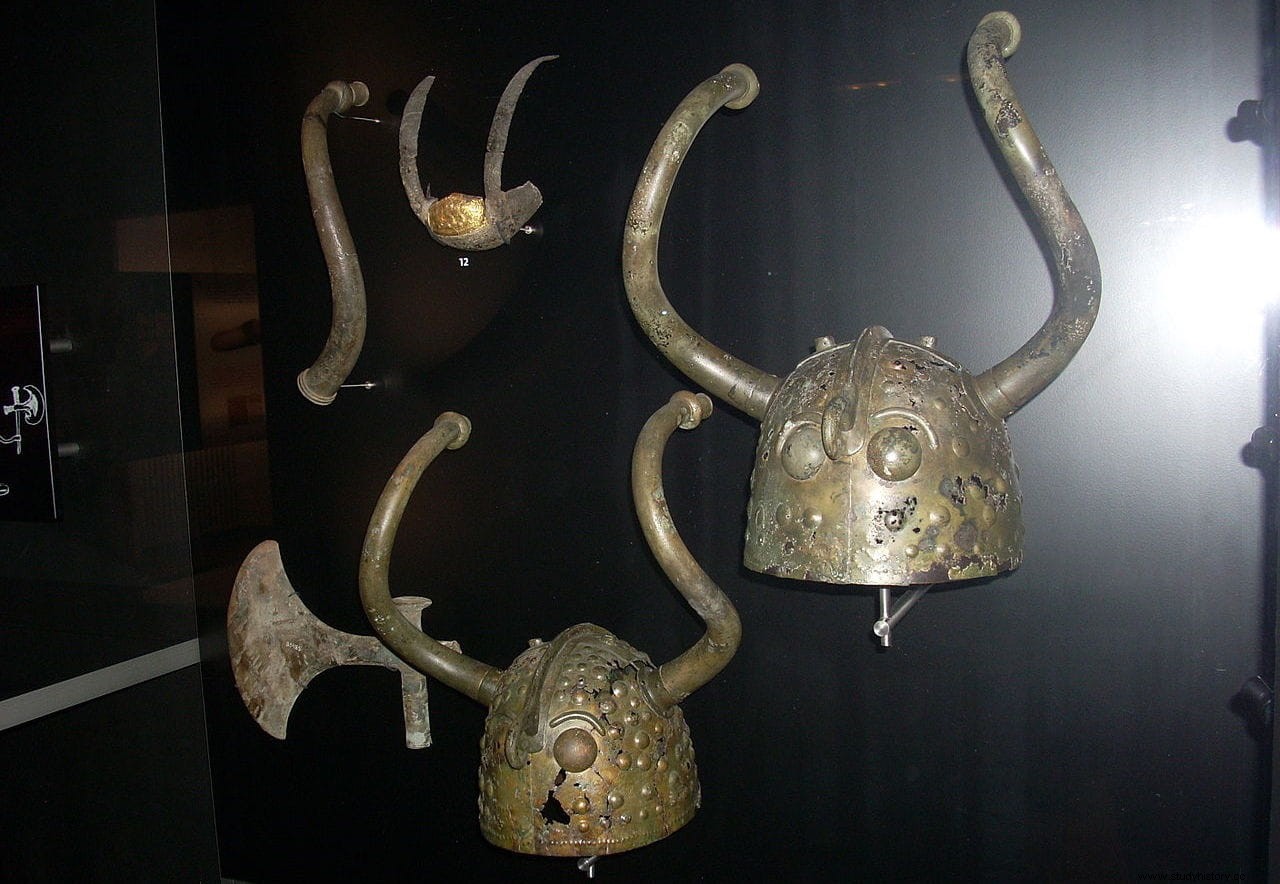In the summer of 1942, a worker named Jens Christensen extracting peat in Brøns Mose, near the town of Veksø on the island of Zealand, Denmark, found a bronze object decorated with a wooden plate that had a groove and looked like a kind of support, buried about 70 centimeters deep.
Immediately subsequent investigations at the find site recovered further fragments of what appeared to be a helmet. The analysis of the remains led to the conclusion that they were two twin helmets, which could also have been adorned with feathers.
The researchers believe that Brøns Mose, the place where they were found, may have been a swampy area during the Bronze Age. It would have been part of the Løge Sø, a nearby lake whose size would have been reduced. If this is correct, the helmets may have been thrown into the swamp as votive offerings or offerings.

Both helmets are nearly identical in design. They are made of bronze with a high tin content (16.8 percent), and resemble Urnfield Culture helmets found elsewhere in Europe between the Danube and the Baltic, and even in the Iberian Peninsula.
They are made up of two hammered pieces joined with rivets by means of a seam that went from front to back at the top, topped with a crest. Each end of this ends in a downward-pointing hook, perhaps representing the beak of a bird of prey.

In the center of the crest is a deep groove into which feathers or locks of hair could be mounted. In the transverse plate that crosses the crest there are also small cylindrical supports for feathers or tufts, one on each side.
The decoration of the helmets includes protrusions of various sizes throughout its surface, of which the largest are the two in the shape of an eye with arched eyebrows. A row of these bosses along the lower edge ends with an S-shaped decoration reminiscent of double-stern ships. On each hull there would be two ships represented, with the prows decorated with an aquatic bird (a duck, a swan or a grebe). They could represent the solar boat, the most important religious symbol of the Bronze Age. Birds were special symbols because they could follow the Sun and its light anywhere, they could dive into water, swim, walk on land, and fly in the sky.
Both helmets bear firmly riveted horns with the help of fixed circular attachments. They are S-shaped, with a twist similar to bull's horns or those of a lur (a wind instrument used in Scandinavia during the Bronze Age). Interestingly, the lur are also often found in pairs in ancient swamps. Icelandic sagas say that these lur were instruments of war, to rally troops and scare the enemy.

Horned helmets are not uncommon at Bronze Age sites in Mediterranean contexts associated with Sea Peoples, and some have also turned up in the Near East. Some researchers believe that in this case the helmets are of Scandinavian manufacture, while others suggest that they may have been imported from the Italian peninsula, since the shape of the horns is reminiscent of the aurochs (Bos primigenius ). Central Europe or northern Germany have also been proposed as places of origin.
According to the review of the National Museum of Copenhagen, where they are kept, the craftsman who made them had a great influence from the bronze works of the eastern part of the Alps. Also, many rock carvings, especially in western Sweden, show men wearing horned helmets.

They have also been linked to the divine twins motif. , a recurring theme in Proto-Indo-European religions, the best-known examples of which include the Greek Dioscuri Castor and Pollux, or the Roman twins Romulus and Remus.
In this sense, the helmets are very similar to those worn by bronze figurines dated between 800 and 500 BC. found on the same island at the end of the 18th century, the Grevensvænge figures. There are seven sculptures of warriors wearing horned helmets and carrying axes, one of them doing what looks like an acrobatic act. Five of them have been lost, and the set is interpreted as representing Alcis, the divine twins worshiped by the Germanic tribe of the Naharvalos.

Both helmets date from the Bronze Age, between 1000 and 800 BC. War helmets from this time were generally equipped with nose guards, and as this is not the case, it is likely that the Veksø helmets were not used for combat, but merely had a ritual function.
The presence of the solar ship would refer to a central myth in the religion of the Bronze Age, that of the eternal journey of the sun, which goes round and round in the solar ship pulled by a horse, which is the most noble and sacred of animals. The horse would be represented on the hooves in the form of the mane that is inserted into the groove of the crest.

The ox, represented by the horns, can symbolize strength and wealth. In many religions, the ox is also a heavenly symbol. The bird of prey, depicted in the eyes and beak of the hooves, may also be related to the myth of the sun's eternal journey. The crane feathers they most likely wore, and which can also be seen on Swedish Bronze Age rock carvings, may be related to the changing of the seasons, as the crane is the largest and most beautiful of migratory birds. /P>
The entire symbolic world represented in the Viksø helmets underlines their function as sacred objects used in religious rituals.
